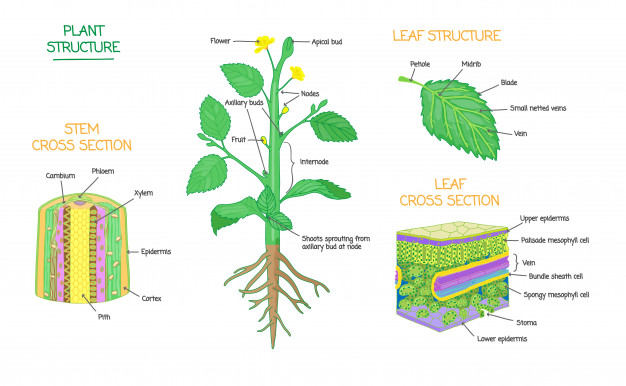Plants are categorized based on many criteria and one such class is the existence or scarcity of a vascular system. Essentially, a vascular plant has hustled features that support it to soak up water and minerals from the soil. These comprise different tissues such as the xylem and phloem.
Xylem and Phloem

Xylem and Phloem are two various types of vascular tissues, which are primarily found in the transportation process. These tissues shape a vascular bundle and specialize together as a unit. The motion of the xylem is unidirectional, while the motion of the phloem is bidirectional.
Xylem is the intricate tissue of plants, used for transporting water and other nutrients to the plants. Phloem is existing tissue, used for transporting food and other organic materials. Xylem comprises dead cells (parenchyma is the only existing cell in the xylem).
Xylem is the complex, lifeless and lasting tissue responsible for carrying nutrients and water, whereas phloem is the soft and permanent tissue and plays its role in transferring the food and other organic material yielded by the green parts especially leaves by the process of photosynthesis.
Let us study the major differences between xylem and phloem in detail.
Major Differences between Xylem and Phloem
Here are some of the major differences between xylem and phloem:
| Xylem | Phloem |
| The structure of Xylem tissues is tubular-shaped, with the lack of cross walls. This tissue conforms to the contour of a star. | The structure of Phloem tissues are tubular-shaped, elongated, structures with the existence of walls with thin sieve tubes. |
| It is found in the center of the vascular bundle. | It is found on the exterior side of the vascular bundle. |
| Xylem fibers are smaller than the phloem. | Phloem fibers are larger than the xylem. |
| They exist in roots, stems, and leaves. | They exist in stems and leaves, which later transports and thrive in roots, fruits, and seeds. |
| The movement of these tissues is Unidirectional. (Only in one direction – upward direction). | The movement of these tissues is Bidirectional. (both ways – up and down) |
| They dwell with hollow dead cells. | They dwell with cytoplasm without the nucleus. |
| The total number of xylem tissues is more. | The total number of phloem tissues is less. |
| It comprises tracheids, vessel elements, xylem parenchyma, xylem sclerenchyma, and xylem fibers. | It comprises four elements: companion cells, sieve tubes, bast fibers, phloem fibers, intermediary cells, and the phloem parenchyma. |
| Transfers soluble mineral nutrients and water molecules from the bottoms to the aerial parts of the plant. | Transfers food and other nutrients comprising a sugar and amino acids from leaves to storage organs and thriving parts of the plant. |
| Shapes vascular bundles with phloem | Shapes vascular bundles with xylem. |
| Contributes mechanical strength to the plant and benefits in strengthening the stem. | Translocates the composite sugars by the photosynthetic regions of plants to repository organs like roots, bulbs, and tubers. |
| It is dependable for restoring the total amount of lost water molecules through transpiration and photosynthesis. | It is dependable for transferring proteins and mRNAs throughout the plant. |
Conclusion
The two most significant intricate kinds of tissue, comprising vascular bundles are the xylem and phloem. We talk about their role that xylem is accountable for transporting water and other soluble materials in the plant in a unidirectional manner.
On the opposite, the function of phloem is to transfer the food and other organic material generated by leaves (through the process of photosynthesis). Hence both the vascular tissues possess equal importance, which is essential for the growth of the plants. If you want to know more, please share your thoughts in the comment box.





